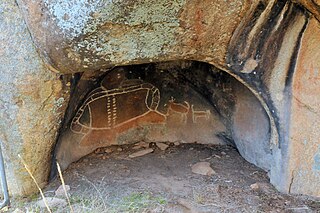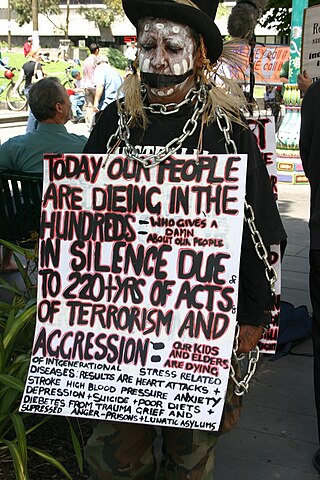Crow steals fire
One common Aboriginal Dreamtime story features Crow's role in bringing fire to mankind. According to oral storytelling by the Wurundjeri people of the Kulin nation, in the Dreamtime fire had been a jealously-guarded secret of the seven Karatgurk women who lived by the Yarra River where Melbourne now stands. These women carried live coals on the ends of their digging sticks, allowing them to cook Murnong yams. One day Crow found a cooked yam and, finding it tastier than the raw vegetables he had been eating, decided he would cook his food from then on. However, the Karatgurk women refused to share their fire with him and Crow resolved to trick them into giving it up. [1] [2] [3]
Crow caught and hid a number of snakes in an ant mound then called the women over, telling them that he had discovered ant larvae were far more tasty than yams. The women began digging, angering the snakes, which attacked. Shrieking, the sisters struck the snakes with their digging sticks, hitting them with such force that the live coals flew off. Crow, who had been waiting for this, gathered the coals up and hid them in a kangaroo skin bag. The women soon discovered the theft and chased him, but the bird simply flew out of their reach and perched at the top of a high tree. [1]
Bunjil the Eaglehawk, who had seen all of this, asked Crow for some of the coals so that he could cook a possum. Crow instead offered to cook it for him. Soon, a large group had gathered around Crow's tree, shouting and demanding that he share the secret of fire with them. The din frightened Crow and at last he flung several live coals at the crowd. Kurok-goru the fire-tailed finch picked up some of the coals and hid them behind his back, which is why to this day firefinches have red tails. The rest were gathered up by Bunjil's shaman helpers, Djurt-djurt the nankeen kestrel and Thara the quail hawk. [1]
The coals caused a bushfire which burnt Crow's feathers permanently black and threatened to consume the entire land, until Bunjil's efforts halted its spread. The Karatgurk sisters, meanwhile, were swept into the sky where they became the Pleiades (the stars are said to represent their glowing fire sticks). [1] [4]
Crow and Magpie
The various groups of Western Australia offer two versions of the same story about the Crow and the Magpie. The crow and the magpie are brothers, [5] both born with pure white feathers. [6] Both were vain and would argue as to which was the most beautiful. Perched in a tree, they began to argue and then fought.
The people with the crow as their totem will tell you the brothers fell into a fire below, the Crow getting burnt all over, the Magpie only partly burnt. Those whom have the magpie as their totem will tell the story the same, but that the brothers fell into thick black mud, and the magpie only slightly stained his feathers, the crow covered in the mud.
As for the crow, as in all Indigenous Australian totems, it is known for its cunning and intelligence, a trickster too, and old spirit with prescient knowledge or carrying old knowledge of many lifetimes (like reincarnation). Very powerful too, as in the totem itself is one of the ones with powerful natural magic, and depending on the language group's own mythology the holder of the totem will either carry great respect, or suspect.

Bunjil, also spelt Bundjil, is a creator deity, culture hero and ancestral being, often depicted as a wedge-tailed eagle in Australian Aboriginal mythology of some of the Aboriginal peoples of Victoria.
In Arrernte mythology, Karora is a bandicoot ancestral deity. According to one legend, during the Dreamtime Karora lay sleeping in the earth when from his head rose a tall pole called a tnatantja. It was a living creature, its bottom resting on his head and its top reaching up into the sky. From his armpits and navel emerged bandicoots, who dug their way out of the earth just as the first sun rose into the sky. Karora followed them, seized two of the animals, then cooked and ate them. His hunger sated, he lay down to sleep again and a bullroarer emerged from under his armpit. It took on human form and grew into a young man, and when Karora woke his son danced around him. It was the very first ceremony.
In Australian Aboriginal mythology, the Wati kutjara are two young lizard-men who, in the Dreaming, travelled all over the Western Desert. In English, their songline is often called the Two Men Dreaming. The Wati kutjara are ubiquitous in the mythology of the Western Desert; Their journey extends for thousands of kilometres, stretching from the Kimberley to South Australia.

The Australian raven is a passerine bird in the genus Corvus native to much of southern and northeastern Australia. Measuring 46–53 centimetres (18–21 in) in length, it has all-black plumage, beak and mouth, as well as strong grey-black legs and feet. The upperparts are glossy, with a purple, blue, or green sheen, and its black feathers have grey bases. The Australian raven is distinguished from the Australian crow species by its throat hackles, which are prominent in adult birds. Older adult individuals have white irises, younger adults have white irises with an inner blue rim, while younger birds have dark brown irises until fifteen months of age, and hazel irises with an inner blue rim around each pupil until age two years and ten months. Nicholas Aylward Vigors and Thomas Horsfield described the Australian raven in 1827, its species name (coronoides) highlighting its similarity with the carrion crow. Two subspecies are recognized, which differ slightly in calls and are quite divergent genetically.
The Boonwurrung people are an Aboriginal people of the Kulin nation, who are the traditional owners of the land from the Werribee River to Wilsons Promontory in the Australian state of Victoria. Their territory includes part of what is now the city and suburbs of Melbourne. They were called the Western Port or Port Philip tribe by the early settlers, and were in alliance with other tribes in the Kulin nation, having particularly strong ties to the Wurundjeri people.

The Taungurung people, also spelt Daung Wurrung, are an Aboriginal people who are one of the Kulin nations in present-day Victoria, Australia. They consist of nine clans whose traditional language is the Taungurung language.
The murnong or yam daisy is any of the plants Microseris walteri, Microseris lanceolata and Microseris scapigera, which are an important food source for many Aboriginal peoples in southern parts of Australia. Murnong is a Woiwurrung word for the plant, used by the Wurundjeri people and possibly other clans of the Kulin nation. They are called by a variety of names in the many different Aboriginal Australian languages, and occur in many oral traditions as part of Dreamtime stories.
Australian Aboriginal astronomy is a name given to Aboriginal Australian culture relating to astronomical subjects – such as the Sun and Moon, the stars, planets, and the Milky Way, and their motions on the sky.

Dja Dja Wurrung, also known as the Djaara or Jajowrong people and Loddon River tribe, are an Aboriginal Australian people who are the traditional owners of lands including the watersheds of the Loddon and Avoca rivers in the Bendigo region of central Victoria, Australia. They are part of the Kulin alliance of Aboriginal Victorian peoples. There are 16 clans, which adhere to a patrilineal system. Like other Kulin peoples, there are two moieties: Bunjil the eagle and Waa the crow.
In the Australian Aboriginal mythology of the Aboriginal people of south-eastern Australian state of Victoria, the Karatgurk were seven sisters who represented the constellation known in western astronomy as the Pleiades.
In the mythology of the Aboriginal people of south-eastern Australia, Balayang or Pallian the bat was a brother of Bunjil the eaglehawk, but lived apart from him. Once, Bunjil asked him to come and live with him, but Balayang replied that Bunjil's country was too dry and that Bunjil ought to come and live with him instead. This upset Bunjil, who sent his two helpers, Djurt-djurt the nankeen kestrel and Thara the quail hawk, after Balayang. They set fire to the bat's country and Balayang and his family were scorched and turned permanently black. Another story says that Balayang formed the oceans, rivers, and creeks.
The Wergaia or Werrigia people are an Aboriginal Australian group in the Mallee and Wimmera regions of north-Western Victoria, made up of a number of clans. The people were also known as the Maligundidj which means the people belonging to the mali (mallee) eucalypt bushland which covers much of their territory.

The Woiwurrung, also spelt Woi-wurrung, Woi Wurrung, Woiwurrong, Woiworung, Wuywurung, are an Aboriginal Australian people of the Woiwurrung language group, in the Kulin alliance.

The theft of fire for the benefit of humanity is a theme that recurs in many world mythologies. This narrative is classified in the Motif-Index of Folk-Literature as motif A1415. Its recurrent themes include a trickster figure as the thief, and a supernatural guardian who hoards fire from humanity, often out of mistrust for humans.

Australian mythology stems largely from Europeans who colonised the country from 1788, subsequent domestic innovation, as well as other immigrant and Indigenous Australian traditions, many of which relate to Dreamtime stories. Australian mythology survives through a combination of word of mouth, historical accounts and the continued practice and belief in Dreamtime within Aboriginal communities.
The Wik-Mungkan people are an Aboriginal Australian group of peoples who traditionally ranged over an extensive area of the western Cape York Peninsula in northern Queensland and speak the Wik Mungkan language. They were the largest branch of the Wik people.
The Dyirbal, also called Jirrbal, are an Aboriginal Australian people living in northern Queensland, both one tribe and a group of related contiguous peoples included under that label as the Dyirbal tribes. They lived on the upper Murray river of the Atherton Tableland. Their name is used as a generic term to refer specifically to one of eight groups, the others being Yidinji, Ngadyan, Mamu, Girramay, Wargamay, Waruŋu and Mbabaɽam.
The Maraura or Marrawarra people are an Aboriginal group whose traditional lands are located in Far West New South Wales and South Australia, Australia.
The Watiwati are an indigenous Australian aboriginal people traditionally living on both sides of the Murray River, from Victoria to New South Wales.







